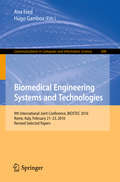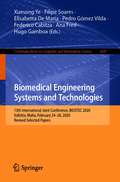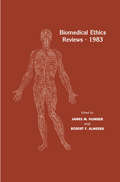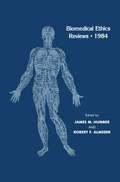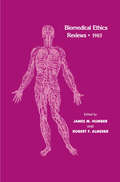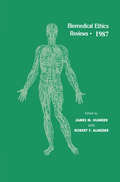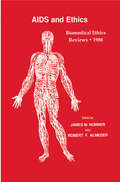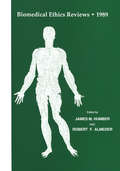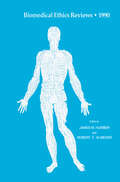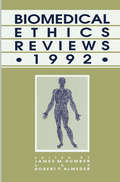- Table View
- List View
Biomedical Engineering Systems and Technologies: International Joint Conference, BIOSTEC 2009, Porto, Portugal, January 14-17, 2009, Revised Selected Papers (Communications in Computer and Information Science #52)
by Ana Fred Joaquim Filipe Hugo GamboaThis book contains the best papers of the Second International Joint Conference on Biomedical Engineering Systems and Technologies (BIOSTEC 2009), organized by the Institute for Systems and Technologies of Information Control and Communi- tion (INSTICC), technically co-sponsored by the IEEE Engineering in Medicine and Biology Society (EMB), IEEE Circuits and Systems Society (CAS) and the Workflow Management Coalition (WfMC), in cooperation with AAAI and ACM SIGART. The purpose of the International Joint Conference on Biomedical Engineering S- tems and Technologies is to bring together researchers and practitioners, including engineers, biologists, health professionals and informatics/computer scientists, int- ested in both theoretical advances and applications of information systems, artificial intelligence, signal processing, electronics and other engineering tools in knowledge areas related to biology and medicine. BIOSTEC is composed of three co-located conferences; each specializes in one of the aforementioned main knowledge areas, namely: • BIODEVICES (International Conference on Biomedical Electronics and - vices) focuses on aspects related to electronics and mechanical engineering, - pecially equipment and materials inspired from biological systems and/or - dressing biological requirements. Monitoring devices, instrumentation sensors and systems, biorobotics, micro-nanotechnologies and biomaterials are some of the technologies addressed at this conference.
Biomedical Engineering Systems and Technologies: 9th International Joint Conference, BIOSTEC 2016, Rome, Italy, February 21–23, 2016, Revised Selected Papers (Communications in Computer and Information Science #690)
by Ana Fred Hugo GamboaThis book constitutes the thoroughly refereed post-conference proceedings of the 9th International Joint Conference on Biomedical Engineering Systems and Technologies, BIOSTEC 2016, held in Rome, Italy, in February 2016. The 22 revised full papers presented were carefully reviewed and selected from a total of 321 submissions. The papers are organized in topical sections on biomedical electronics and devices; bioimaging; bioinformatics models, methods and algorithms; bio-inspired systems and signal processing; health informatics.
Biomedical Engineering Systems and Technologies: 16th International Joint Conference, BIOSTEC 2023, Lisbon, Portugal, February 16–18, 2023, Revised Selected Papers (Communications in Computer and Information Science #2079)
by Ana Fred Hugo Gamboa Hesham Ali Ioanna Chouvarda Federico Cabitza Katja Bühler Ana Moita Ning DengThis book constitutes the refereed post-conference proceedings of the 16th International Joint Conference on Biomedical Engineering Systems and Technologies, BIOSTEC 2023, held in Lisbon, Portugal, during February 16-18, 2023. The 7 regular papers included in this book were carefully reviewed and selected from 246 submissions. They contribute to the understanding of relevant trends of current research on Biomedical Engineering Systems and Technologies, that include Pattern Recognition and Machine Learning, Decision Support Systems, Data Mining and Data Analysis, eHealth Applications, eHealth, Detection and Identification, Computational Intelligence, Cognitive Informatics, Big Data in Healthcare and Assistive Technologies.
Biomedical Engineering Systems and Technologies: 8th International Joint Conference, BIOSTEC 2015, Lisbon, Portugal, January 12-15, 2015, Revised Selected Papers (Communications in Computer and Information Science #574)
by Ana Fred Hugo Gamboa Dirk EliasThis book constitutes the thoroughly refereed post-conference proceedings of the 8th International Joint Conference on Biomedical Engineering Systems and Technologies, BIOSTEC 2015, held in Lisbon, Portugal, in January 2015.The 27 revised full papers presented together with an invited paper were carefully reviewed and selected from a total of 375 submissions. The papers cover a wide range of topics and are organized in four general topical sections on biomedical electronics and devices; bioimaging; bioinformatics models, methods and algorithms; bio-inspired systems and signal processing; health informatics.
Biomedical Engineering Systems and Technologies: 5th International Joint Conference, BIOSTEC 2012, Vilamoura, Portugal, February 1-4, 2012, Revised Selected Papers (Communications in Computer and Information Science #357)
by Joaquim Gabriel Jan Schier Sabine Van Huffel Emmanuel Conchon Carlos Correia Ana Fred Hugo GamboaThis book constitutes the thoroughly refereed post-conference proceedings of the 5th International Joint Conference on Biomedical Engineering Systems and Technologies, BIOSTEC 2012, held in Vilamoura, Portugal, in February 2012. The 26 revised full papers presented together with one invited lecture were carefully reviewed and selected from a total of 522 submissions. The papers cover a wide range of topics and are organized in four general topical sections on biomedical electronics and devices; bioinformatics models, methods and algorithms; bio-inspired systems and signal processing; health informatics.
Biomedical Engineering Systems and Technologies: 14th International Joint Conference, BIOSTEC 2021, Virtual Event, February 11–13, 2021, Revised Selected Papers (Communications in Computer and Information Science #1710)
by Claudine Gehin Bruno Wacogne Alexandre Douplik Ronny Lorenz Bethany Bracken Cátia Pesquita Ana Fred Hugo GamboaThis book constitutes the refereed proceedings of the 14th International Joint Conference on Biomedical Engineering Systems and Technologies, BIOSTEC 2021, held virtually due to the COVID-19 crisis, in February 2021. The conference was held virtually due to the COVID-19 crisis.The 13 full papers included in this book were carefully reviewed and selected from 265 submissions. The papers selected to be included in this book contribute to the understanding of relevant trends of current research on Biomedical Engineering Systems and Technologies, including: Pattern Recognition and Machine Learning, Application of Health Informatics in Clinical Cases, Evaluation and Use of Healthcare IT, Medical Signal Acquisition, Analysis and Processing, Data Mining and Data Analysis, Decision Support Systems, e-Health, e-Health Applications, Mobile Technologies for Healthcare Applications and Medical Devices design.
Biomedical Engineering Systems and Technologies: 10th International Joint Conference, BIOSTEC 2017, Porto, Portugal, February 21–23, 2017, Revised Selected Papers (Communications in Computer and Information Science #881)
by Nathalia Peixoto Margarida Silveira Hesham H. Ali Carlos Maciel Egon L. van den BroekThis book constitutes the thoroughly refereed post-conference proceedings of the 10th International Joint Conference on Biomedical Engineering Systems and Technologies, BIOSTEC 2017, held in Porto, Portugal, in February 2017.The 20 revised full papers presented were carefully reviewed and selected from a total of 297 submissions. The papers are organized in topical sections on biomedical electronics and devices; bioimaging; bioinformatics models, methods and algorithms; bio-inspired systems and signal processing; and health informatics.
Biomedical Engineering Systems and Technologies: 7th International Joint Conference, BIOSTEC 2014, Angers, France, March 3-6, 2014, Revised Selected Papers (Communications in Computer and Information Science #511)
by Guy Plantier Tanja Schultz Ana Fred Hugo GamboaThis book constitutes the thoroughly refereed post-conference proceedings of the 7th International Joint Conference on Biomedical Engineering Systems and Technologies, BIOSTEC 2014, held in Angers, France, in March 2014. The 25 revised full papers presented were carefully reviewed and selected from a total of 362 submissions. The papers cover a wide range of topics and are organized in topical sections on biomedical electronics and devices; bioimaging; bioinformatics models, methods and algorithms; bio-inspired systems and signal processing; health informatics.
Biomedical Engineering Systems and Technologies: 12th International Joint Conference, BIOSTEC 2019, Prague, Czech Republic, February 22–24, 2019, Revised Selected Papers (Communications in Computer and Information Science #1211)
by Ana Roque Arkadiusz Tomczyk Elisabetta De Maria Felix Putze Roman Moucek Ana Fred Hugo GamboaThis book constitutes the thoroughly refereed post-conference proceedings of the 12th International Joint Conference on Biomedical Engineering Systems and Technologies, BIOSTEC 2019, held in Prague, Czech Republic, in February 2019.The 22 revised and extended full papers presented were carefully reviewed and selected from a total of 271 submissions. The papers are organized in topical sections on biomedical electronics and devices; bioimaging; bioinformatics models, methods and algorithms; bio-inspired systems and signal processing health informatics.
Biomedical Engineering Systems and Technologies: 13th International Joint Conference, BIOSTEC 2020, Valletta, Malta, February 24–26, 2020, Revised Selected Papers (Communications in Computer and Information Science #1400)
by Xuesong Ye Filipe Soares Elisabetta De Maria Pedro Gómez Vilda Federico Cabitza Ana Fred Hugo GamboaThis book constitutes extended and revised versions of the selected papers from the 13th International Joint Conference on Biomedical Engineering Systems and Technologies, BIOSTEC 2020, held in Valletta, Malta, in February 2020.The 29 revised and extended full papers presented were carefully reviewed and selected from a total of 363 submissions. The papers are organized in topical sections on biomedical electronics and devices; bioimaging; bioinformatics models, methods and algorithms; bio-inspired systems and signal processing; health informatic
Biomedical Engineering Technologies: Volume 1 (Methods in Molecular Biology #2393)
by Miguel R. Ossandon Houston Baker Avraham RasoolyThis volume provides detailed technical protocols on current biosensors and imaging technologies and Chapters focus on optical, electrochemical, Quartz crystal microbalance (QCM) biosensors and on medical imaging technologies such as tomography, MRI, and NMR. Written in the format of the highly successful Methods in Molecular Biology series, each chapter includes an introduction to the topic, lists necessary materials and reagents, includes tips on troubleshooting and known pitfalls, and step-by-step, readily reproducible protocols. Authoritative and practical, Biomedical Engineering Technologies, Volume 1 provides technical details in descriptions of major technologies by experts in the field.
Biomedical EPR - Part A: Free Radicals, Metals, Medicine and Physiology (Biological Magnetic Resonance #23)
by Sandra S. Eaton Gareth R. Eaton Lawrence J. BerlinerBiomedical EPR – Part A focuses on applications of EPR spectroscopy in the areas of free radicals, metals, medicine, and physiology. The book celebrates the 70th birthday of Prof. James S. Hyde, Medical College of Wisconsin, and his contributions to this field. Chapters are written to provide introductory material for new-comers to the field which lead into up-to-date reviews that provide perspective on the wide range of questions that can be addressed by EPR. Key Features:Free Radicals in Medicine Radicals in vivo and in Model Systems, and their Study by Spin Trapping In vivo EPR, including Oximetry and Imaging Time Domain EPR at Radio Frequencies EPR of Copper Complexes: Motion and Frequency Dependence Time Domain EPR and Electron Spin Echo Envelope Modulation
Biomedical EPR - Part B: Methodology, Instrumentation, and Dynamics (Biological Magnetic Resonance #24)
by Sandra S. Eaton Gareth R. Eaton Lawrence BerlinerBiomedical EPR – Part B focuses on applications of EPR techniques and instrumentation, with applications to dynamics. The book celebrates the 70th birthday of Prof. James S. Hyde, Medical College of Wisconsin, and his contributions to this field. Chapters are written to provide introductory material for new-comers to the field that lead into up-to-date reviews that provide perspective on the wide range of questions that can be addressed by EPR. Key Features:EPR Techniques including Saturation Recovery, ENDOR, ELDOR, and Saturation Transfer Instrumentation Innovations including Loop Gap Resonators, Rapid Mixing, and Time Locked Sub-Sampling Motion in Biological Membranes Applications to Structure Determination in Proteins Discussion of Trends in EPR Technology and Prognosis for the Future
Biomedical Ethics Reviews · 1983 (Biomedical Ethics Reviews)
by James M. Humber Robert F. AlmederIn the past decade the body of literature in the area of biomedical ethics has expanded at an astounding rate. Indeed, on every major topic, the literature in this area has mUltiplied, and continues to do so, so rapidly that one can easily fall behind important advances in our thinking about and understanding of the problems of contemporary bioethics. Awareness of this need to keep apace of developments in the area prompted a recent reviewer of our earlier collection Biomedical Ethics and the Law (Plenum, 2nd edition, 1979) to suggest that somebody ought to offer the service of providing a biennial review or update of the literature on the various central topics in bioethics. Thomas Lanigan, of The Humana Press, agreed with this last sug gestion and so asked us to edit a series of texts consisting of previously unpublished essays on selected topics, a series that would seek to re view and update recent literature on the central topics, while also striv ing to advance distinctive solutions to the problems on the topics under discussion. Accordingly, this first collection of previously unpublished essays focuses on the selected topics, and the authors commissioned were charged with addressing the basic problems assigned while also bringing the reader either directly or indirectly up to date on the rele vant literature.
Biomedical Ethics Reviews · 1984 (Biomedical Ethics Reviews)
by James M. Humber Robert F. AlmederThis is the second volume of Biomedical Ethics Reviews, a series of texts designed to review and update the literature on issues of central importance in bioethics today. Five topics are dis cussed in the present volume. Section I, Public Policy andRe search with Human Subjects, reviews the history of the moral issues involved in the history of research with human subjects, and confronts most of the major legal and moral problems involving research on human subjects. Questions addressed in this section range from those concerning informed and proxy consent to those dealing with the adequacy of monitoring hu man research via institutional review boards (IRBs). Section II deals with a second broad topic in bioethics, The Right to Health Care in a Democratic Society. Here the concern not merely that of determining whether there is a right to is health care, but also, if there is such a right, how it ought best be understood and implemented. To answer questions such as these, we learn that one must distinguish legal from moral rights, assess the merits of various theories of rights, clarify the relationship between rights and duties, and attempt to deter mine a just method for the distribution of health care. Advances in medical technology often pose new legal and moral problems for legislators and health care practitioners.
Biomedical Ethics Reviews · 1985 (Biomedical Ethics Reviews)
by James M. Humber Robert F. AlmederBiomedical Ethics Reviews: 1985 is the third volume in a series of texts designed to review and update the literature on issues of central impor tance in bioethics today. Four topics are discussed in the present volume: ( 1) Should citizens of the United States be permitted to buy, sell, and broker human organs? (2) Should sex preselection be legally proscribed? (3) What decision-making procedure should medical per sonnel employ in those cases where there is a high degree of uncer tainty? (4) What do we mean when we use the terms "health" and "disease"? Each topic constitutes a separate section in our text; intro ductory essays briefly summarize the contents of each section. Bioethics is, by its nature, interdisciplinary in character. Recognizing this fact, the authors represented in the present volume have made every effort to minimize the use of technical jargon. At the same time, we believe the purpose of providing a review of the recent literature, as well as of advancing bioethical discussion, is admirably served by the pieces collected herein. We look forward to the next volume in our series, and very much hope the reader will also.
Biomedical Ethics Reviews · 1987 (Biomedical Ethics Reviews)
by James M. Humber Robert F. AlmederBiomedical Ethics Reviews • 1987 is the fifth volume in a series of texts designed to review and update the literature on issues of central importance in bioethics today. Three topics are discussed in the present volume: (1) Prescribing Drugs for the Aged and Dying; (2) Animals as a Source of Human Transplant Organs, and (3) The Nurse's Role: Rights and Responsibilities. Each topic constitutes a separate sec tion in our text; introductory essays briefly summarize the contents of each section. Bioethics is, by its nature, interdisciplinary in character. Recognizing this fact, the authors represented in the present volume have made every effort to minimize the use of techni cal jargon. At the same time, we believe the purpose of pro viding a review of the recent literature, as well as of advancing bioethical discussion, is admirably served by the pieces col lected herein. We look forward to the next volume in our series, and very much hope the reader will also.
Biomedical Ethics Reviews · 1988 (Biomedical Ethics Reviews)
by James M. Humber Robert F. AlmederBiomedical Ethics Reviews is an annual publication designed to review and update the literature on issues of central importance in bioethics today. Ordinarily, more than one topic is discussed in each volume of Biomedical Ethics Reviews. This year, however, we have decided to devote the entire volume of Biomedical Ethics Reviews: 1988 to disussion of one topic, namely, AIDS. The ra tionale for this decision should be clear: AIDS is arguably the most serious public health threat facing our nation today, and the char acter of the disease is such that it creates special problems for ethicists, philosophers, theologians, educators, jurists, health care professionals, and politicians. Indeed, the questions that AIDS gives rise to are so numerous and complex that no one text could hope to treat them exhaustively. Still, if it is impossible, in anyone text, to deal with all of the perplexing difficulties that AIDS generates, it nevertheless remains true that each addition to the AIDS literature contributes to our collective knowledge, and in so doing, brings us one step closer to resolving at least some of the problems associated with the disease. We believe that the articles included in the present volume of Biomedical Ethics Reviews serve this purpose admirably, and we hope the reader will agree. James M. Humber Robert F. Almeder vii Contributors Ronald Carson • Medical Humanities Institute, University of Texas Medical Branch, Galveston, Texas David J.
Biomedical Ethics Reviews · 1989 (Biomedical Ethics Reviews)
by James M. Humber Robert F. AlmederBiomedical Ethics Reviews • 1989 is the seventh volume in a series of texts designed to review and update the literature on issues of central importance in bioethics today. Three topics are discussed in the present volume: (1) Should Abnormal Fetuses Be Brought to Term for the Sole Purpose of Providing Infant Transplant Organs? (2) Should Physicians Dispense Drugs for Profit? and (3) Should Human Death Be Taken to Occur When Persons Perma nently Lose Consciousness? Each topic constitutes a separate section in our text; introductory essays briefly summarize the contents of each section. Bioethics is, by its nature, interdisciplinary in character. Recog nizing this fact, the authors represented in the present volume have made every effort to minimize the use of technical jargon. At the same time, we believe the purpose of providing a review of the recent literature, as well as of advancing bioethical discussion, is admirably served by the pieces collected herein. We look forward to the next volume in our series, and very much hope the reader will also.
Biomedical Ethics Reviews · 1990 (Biomedical Ethics Reviews)
by James M. Humber Robert F. AlmederBiomedical Ethics Reviews • 1990 is the eighth volume in a series of texts designed to review and update the literature on issues of central importance in bioethics today. Two topics are discussed in the present volume: (1) Should the United States Adopt a National Health Insurance Plan? and (2) Are the NIH Guidelines Adequate for the Care and Protection of Laboratory Animals? Each topic constitutes a separate section in our text; introductory essays briefly summarize the contents of each section. Bioethics is, by its nature, interdisciplinary in character. Recog nizing this fact, the authors represented in the present volume have made every effort to minimize the use of technical jargon. At the same time, we believe the purpose of providing a review of the recent literature, as well as of advancing bioethical discussion, is admirably served by the pieces collected herein. We look forward to the next volume in our series, and very much hope the reader will also.
Biomedical Ethics Reviews · 1992 (Biomedical Ethics Reviews)
by James M. Humber Robert F. AlmederBiomedical Ethics Reviews: 1992 is the tenth volume in a series of texts designed to review and update the literature on issues of central importance in bioethics today. Two topics are discussed in the present volume: (1) Bioethics and the Military, and (2) Compulsory Birth Control. Each topic constitutes a separate section in our text; introductory essays briefly summarize the contents of each section. Bioethics is, by its nature, interdisciplinary in character. Recog nizing this fact, the authors represented in the present volume have made every effort to minimize the use of technical jargon. At the same time, we believe the purpose of providing a review of the recent literature, as well as of advancing bioethical discussion, is well served by the pieces collected herein. We look forward to the next volume in our series, and very much hope the reader will also. James M. Humber Robert F. Almeder vii Contributors Paul Christopher • Department of English and Philosophy Division, US Military Academy, West Point, New York Gerard Elfstrom • Department of Philosophy, Auburn University, Auburn, Alabama Nicholas Fotion • Department of Philosophy, Emory University, Atlanta, Georgia Martin Gunderson • Department of Philosophy, Macalester College, St.
Biomedical Image Analysis
by Rangaraj M. RangayyanComputers have become an integral part of medical imaging systems and are used for everything from data acquisition and image generation to image display and analysis. As the scope and complexity of imaging technology steadily increase, more advanced techniques are required to solve the emerging challenges.Biomedical Image Analysis demonstr
Biomedical Image Processing (Biological and Medical Physics, Biomedical Engineering)
by Thomas Martin DesernoIn modern medicine, imaging is the most effective tool for diagnostics, treatment planning and therapy. Almost all modalities have went to directly digital acquisition techniques and processing of this image data have become an important option for health care in future. This book is written by a team of internationally recognized experts from all over the world. It provides a brief but complete overview on medical image processing and analysis highlighting recent advances that have been made in academics. Color figures are used extensively to illustrate the methods and help the reader to understand the complex topics.
Biomedical Image Registration: 5th International Workshop, WBIR 2012, Nashville, TN, USA, July 7-8, 2012, Proceedings (Lecture Notes in Computer Science #7359)
by Benoit Dawant Gary E. Christensen J. Michael Fitzpatrick Daniel RueckertThis book constitutes the refereed proceedings of the 5th International Workshop on Biomedical Image Registration, WBIR 2012, held in Nashville, Tennessee, USA, in July 2012. The 20 full papers and 11 poster papers included in this volume were carefully reviewed and selected from 44 submitted papers. They full papers are organized in the following topical sections: multiple image sets; brain; non-rigid anatomy; and frameworks and similarity measures.
Biomedical Image Registration: 4th International Workshop, WBIR 2010, Lübeck, July 11-13, 2010, Proceedings (Lecture Notes in Computer Science #6204)
by Bernd Fischer Benoit Dawant Cristian LorenzWelcome to the proceedings of the 4th Workshop on Biomedical Image R- istration (WBIR). Previous WBIRs took place in Bled, Slovenia (1999), at the UniversityofPennsylvania,USA(2003)andinUtrecht,TheNetherlands(2006). This year, WBIR was hosted by the Institute Mathematics and Image Proce- ing and the Fraunhofer Project Group on Image Registration and it was held in Lub ¨ eck, Germany. It provided the opportunity to bring together researchers from all over the world to discuss some of the most recent advances in image registration and its applications. We had an excellent collection of papers that were reviewed by at least three reviewers each from a 35-member Program Committee assembled from a wor- wide community of registration experts. This year 17 papers were accepted for oral presentation, while another 7 papers were accepted as poster papers. We believe all of the conference papers were of excellent quality. Registration is a fundamental task in image processing used to match two or more pictures taken, for example, at di?erent times, from di?erent sensors, or from di?erent viewpoints. Establishing the correspondence of structures within medical images is fundamental to diagnosis, treatment planning, and surgical guidance. The conference papers address state-of-the-art techniques for prov- ing reliable and e?cient registration techniques, thereby imposing relationships between speci?c application areas and appropriate registration schemes. We are grateful to all those who contributed to the success of WBIR 2010.

